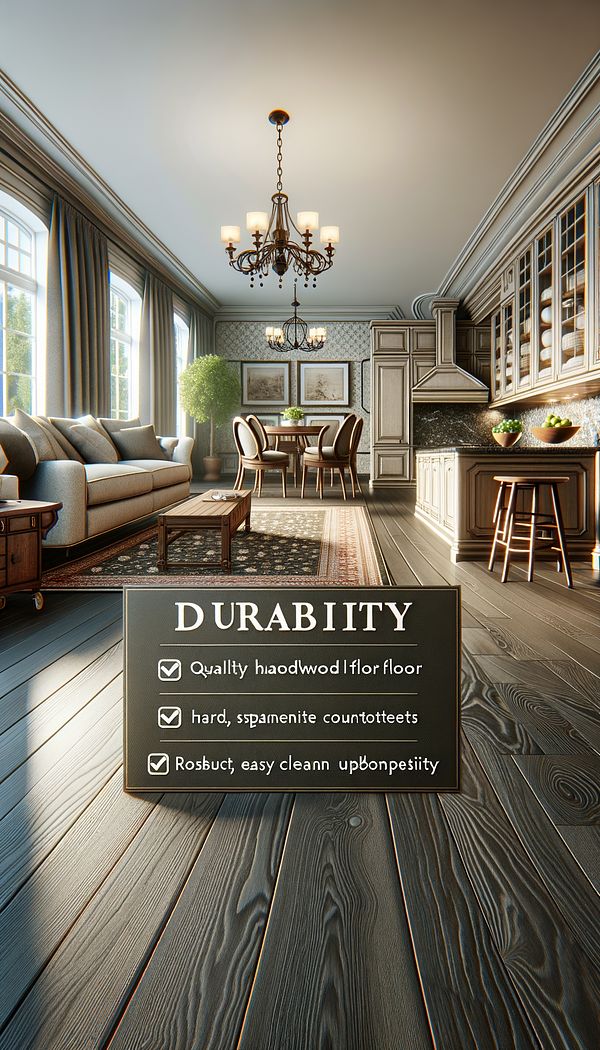What is Durability?
Durability refers to the ability of a material, object, or design element to withstand wear, pressure, or damage.
Description
Durability is a fundamental aspect in the realm of interior design, where the longevity and resilience of materials and products are critical to both aesthetics and functionality. It encompasses the ability of an item — be it furniture, flooring, textiles, or decorative objects — to maintain its integrity and appearance over time, despite regular use and the inevitable wear and tear of daily life.
Beyond the simple resistance to physical damage, durability also involves maintaining color fastness, structural integrity, and resisting environmental factors such as UV exposure, humidity, and temperature fluctuations. It's not just about how well something holds up physically, but also how it retains its aesthetic appeal over time.
Selecting durable materials and products is essential for ensuring that interiors not only look beautiful upon completion but remain functional and appealing for years to come. This selection process often requires balancing cost with expected lifespan, maintenance needs, and the specific demands of the interior environment where the items will be used.
Sustainability is also closely linked with durability. Items that last longer reduce the need for frequent replacements, thereby contributing to lesser waste and supporting sustainable living and design practices.
Usage
In a commercial setting, such as a hotel lobby, durability might be prioritized when selecting materials for flooring and furniture to ensure they can withstand high traffic. In homes, kitchen countertops made from durable materials like granite or quartz are favored for their ability to resist scratches and stains. Additionally, outdoor furniture and accessories are designed with durability in mind to survive weather-related wear and tear.
FAQs
-
How does durability impact the cost of interior design projects?
Durability often influences the initial cost of materials and products due to higher quality and longer-lasting attributes. However, investing in durable items can lead to long-term savings by reducing the need for frequent replacements and repairs, thereby offering better cost-effectiveness over time.
-
Why is durability important in sustainable design?
Durability is crucial in sustainable design because it prolongs the lifespan of materials and products, which reduces waste and conserves resources. By choosing durable items, interior design can contribute to a healthier environment and the promotion of sustainable living practices.
-
How do you assess the durability of a material or product?
The durability of a material or product can be assessed by examining its resistance to wear and tear, structural composition, maintenance requirements, and manufacturer warranties. Additionally, consulting industry standards and certifications related to durability can provide valuable insight.
-
Can durable designs be stylish?
Absolutely. Durable designs do not have to compromise on style. Many materials and products combine high durability with aesthetic appeal, allowing for functional spaces that are also visually striking. With advancements in technology and manufacturing, the options for durable yet stylish design elements have significantly increased.
Practical Application
When planning an interior design project, consider the space's intended use and select materials that offer the desired level of durability. For high-traffic areas, choose hard-wearing materials such as hardwood flooring or commercial-grade fabrics. Keep in mind factors like exposure to sunlight, moisture, and heavy use, which can all influence the durability of different design elements. Regular maintenance can also extend the lifespan of durable materials, ensuring they perform well and look good for years to come.
-
Furniture Types599 articles
-
Decorative Objects240 articles
-
Decorating Principles & Elements330 articles
-
Materials & Textiles360 articles
-
Sustainability & Eco-Friendly Design69 articles
-
ParquetParquet is a geometric mosaic of wood pieces used for decorative flooring.
-
Asian StyleAsian Style refers to the interior design practice that incorporates elements inspired by the countries and cultures of Asia.
-
Wrap GroupWrap Group refers to a methodology of grouping furniture and decor items to create a cohesive and visually appealing arrangement.
-
Flemish ScrollA decorative motif featuring a symmetrical scroll with curves that meet in the middle.
-
StuccoStucco is a type of plaster used as a coating for walls and ceilings.
